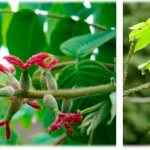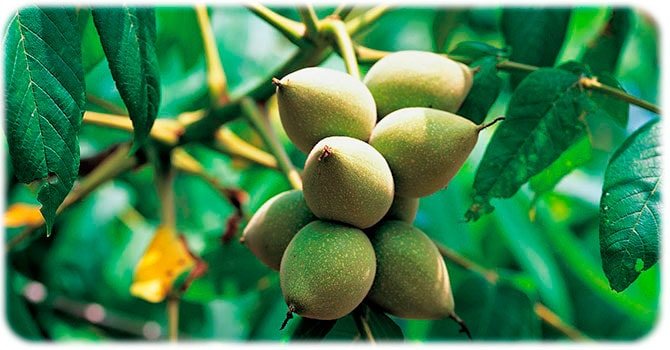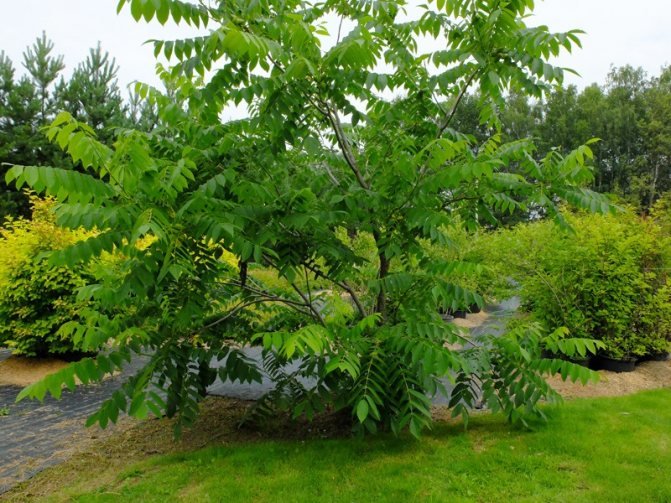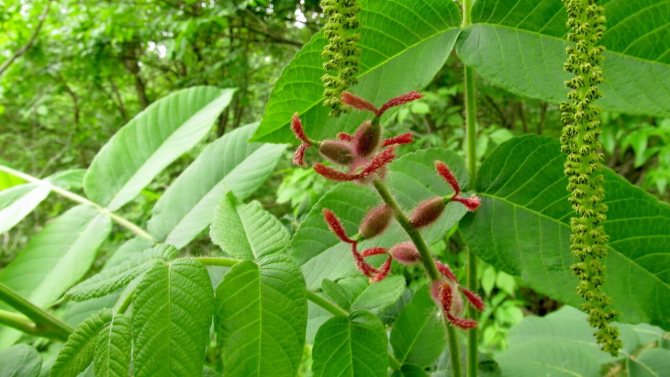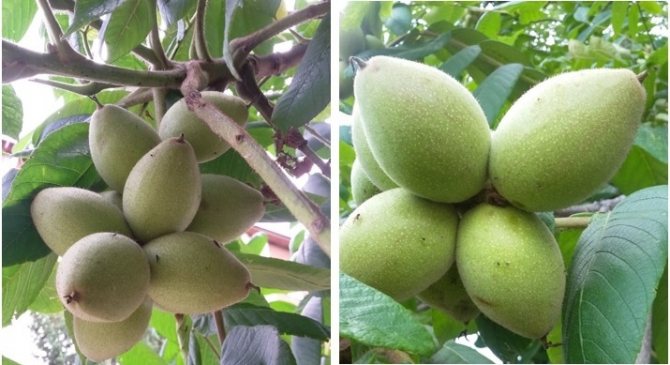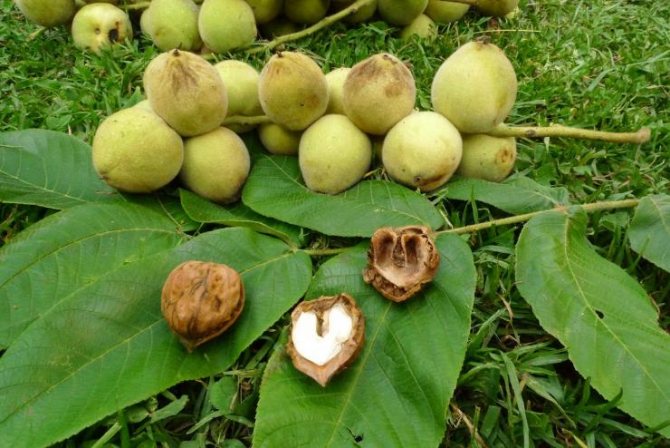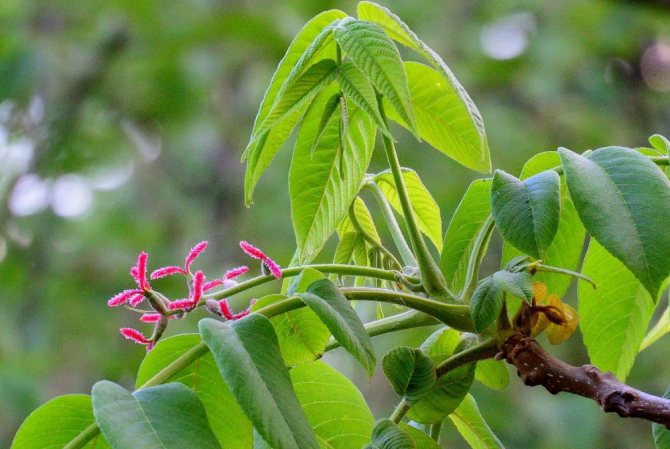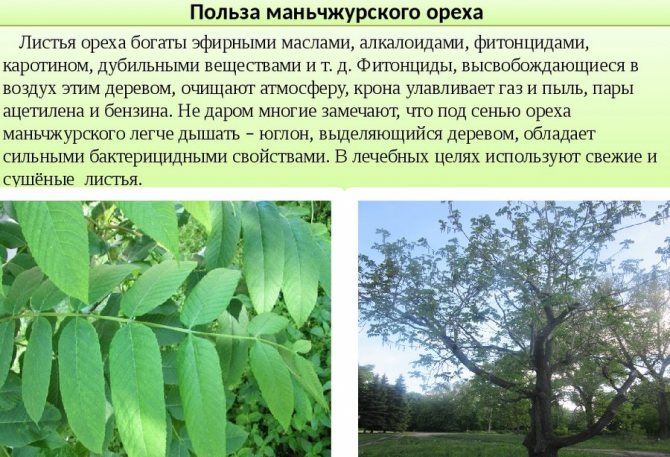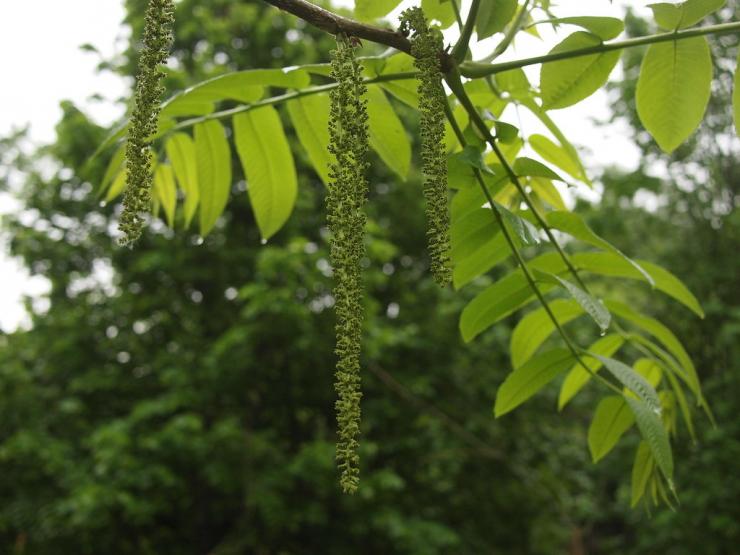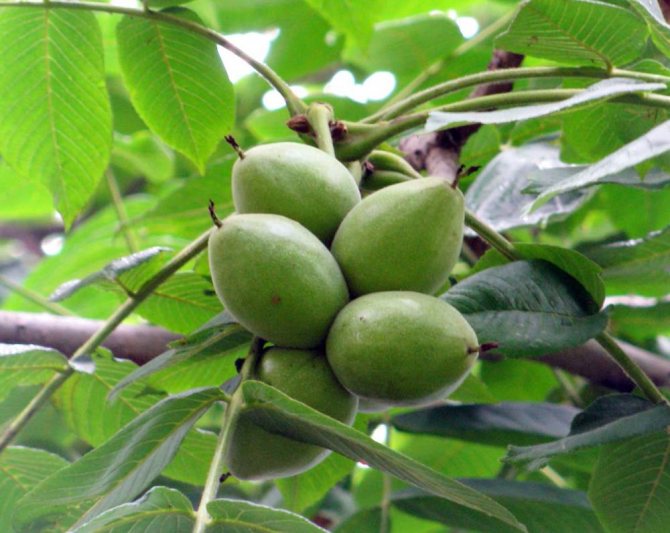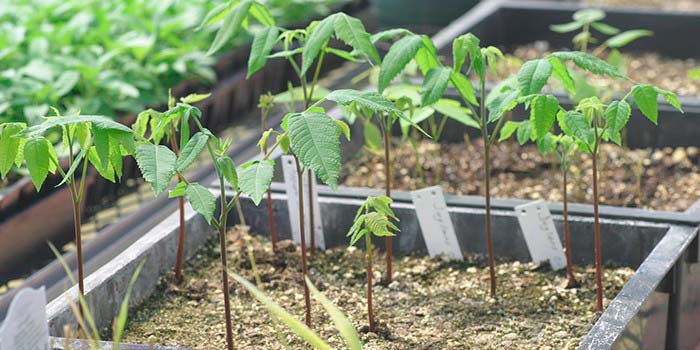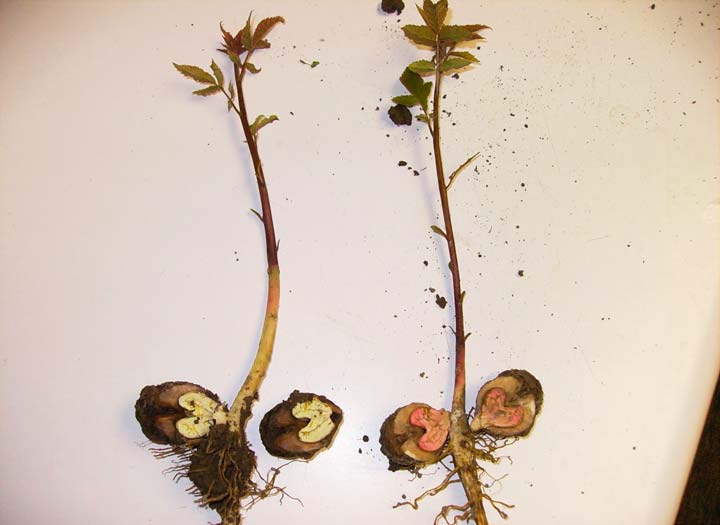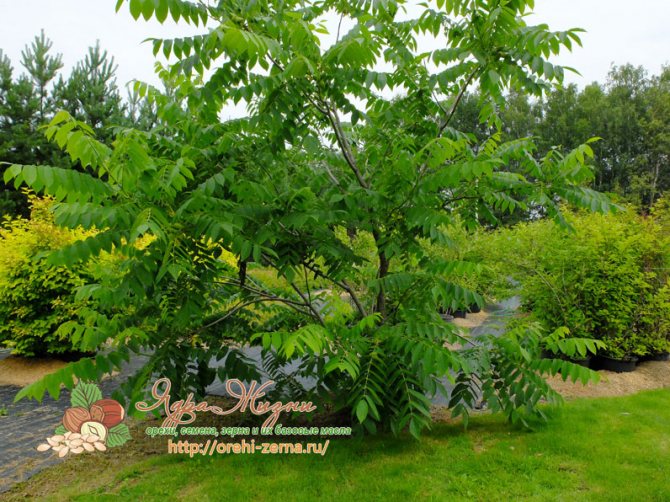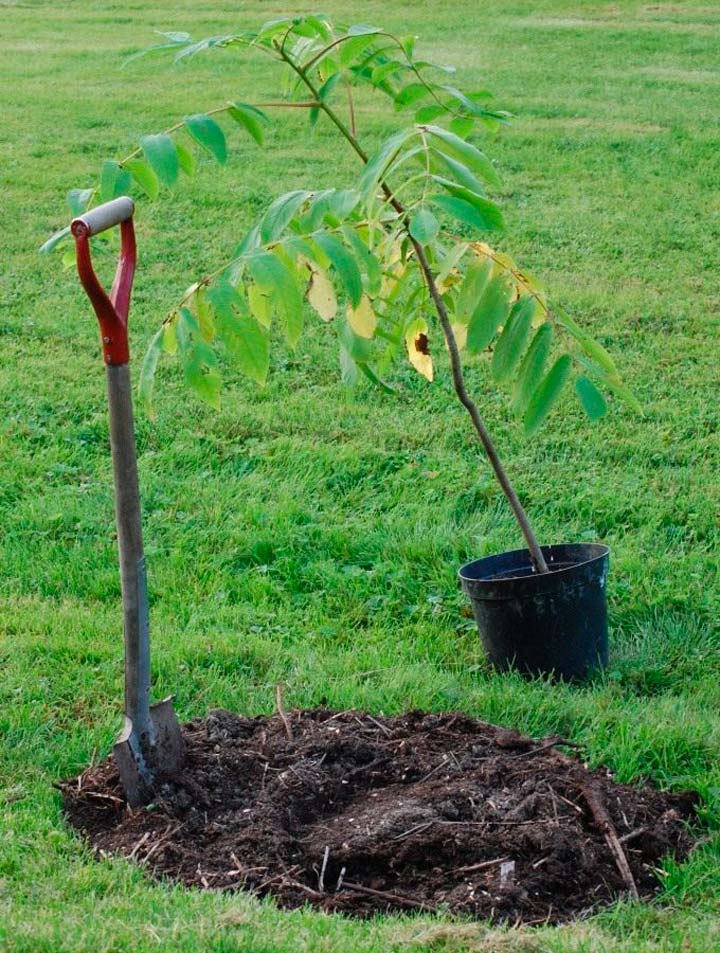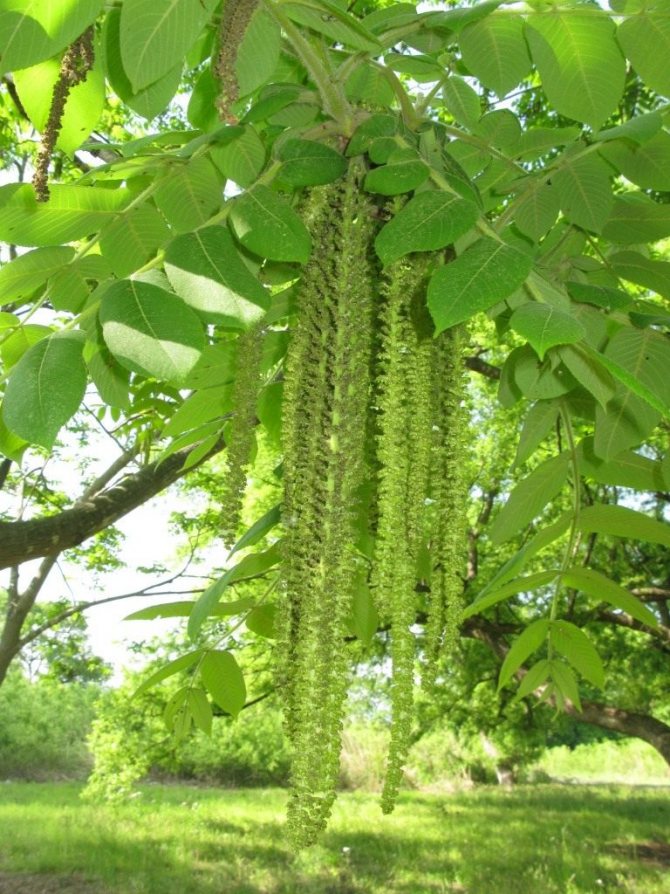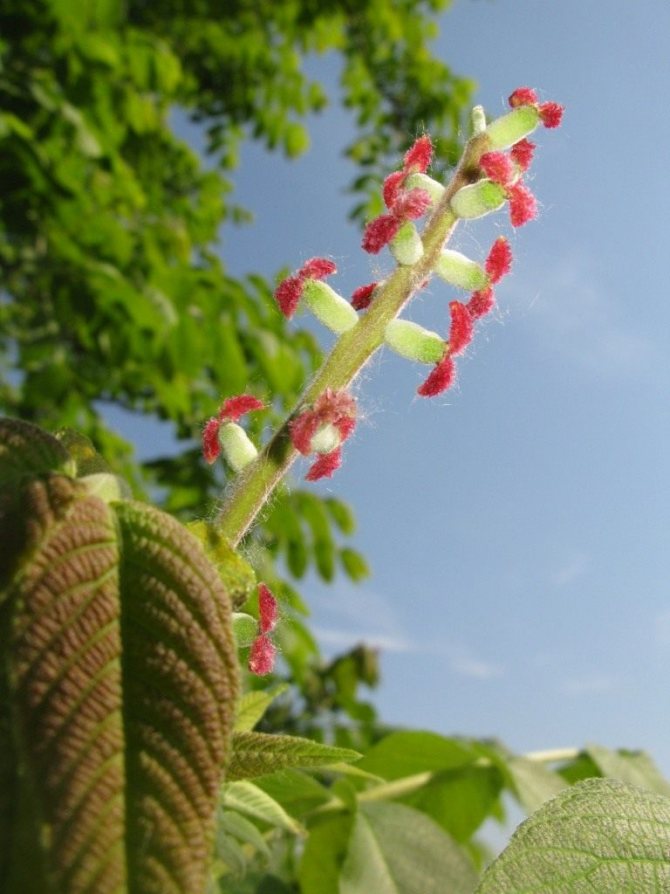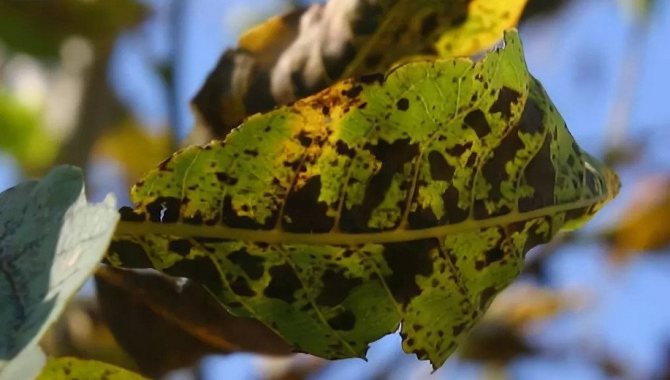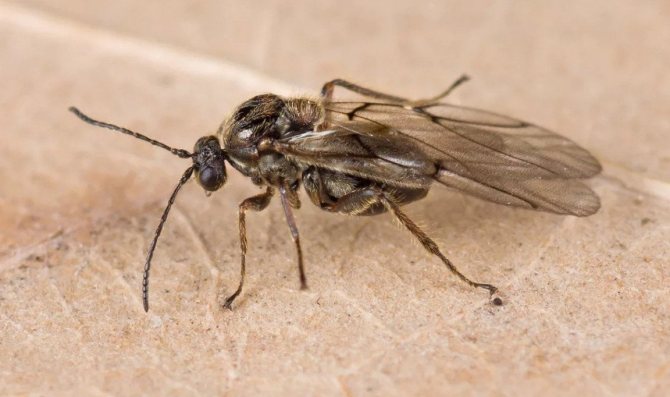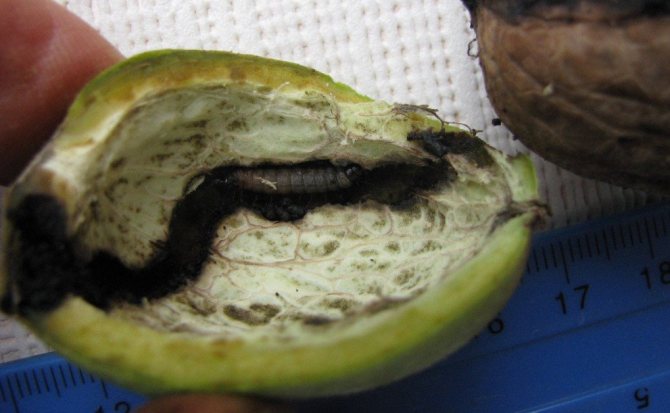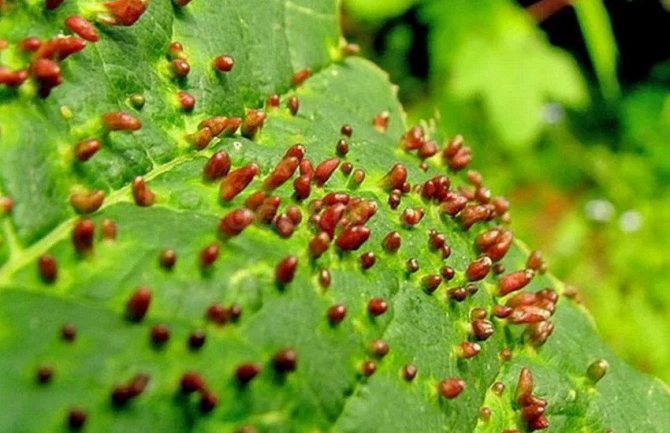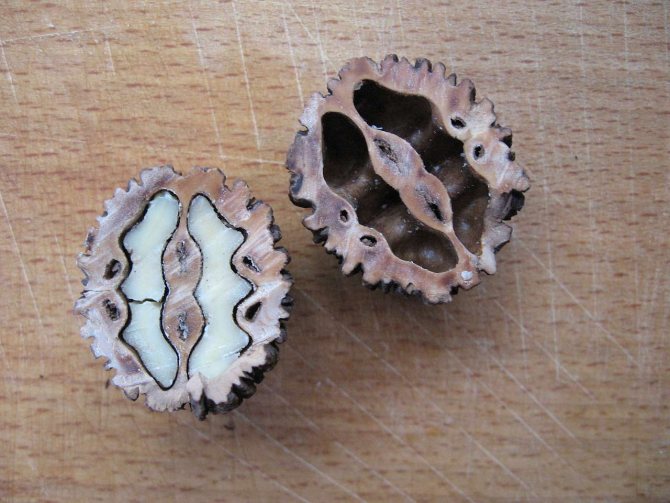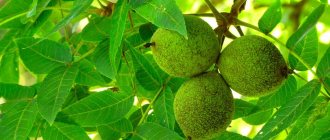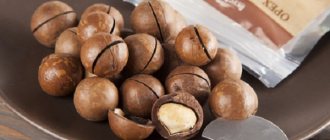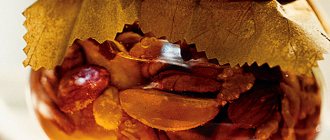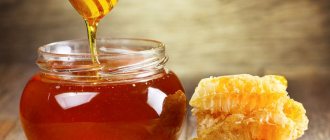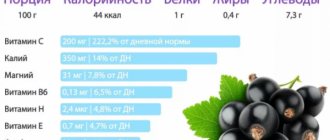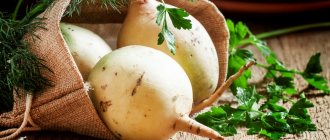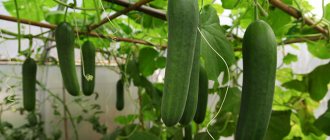The Manchurian walnut belongs to the walnut family and is considered the closest relative of the walnut. In addition to its attractive appearance, the culture has pronounced healing properties and is appreciated not only in various fields of medicine, but also in cosmetology and cooking.
In this article, we will talk about the description of the Manchurian nut, its medicinal benefits and harm to the body, and also learn how to take care of it in your summer cottage.
What it is
The Manchurian walnut, also called the Dumbey or Siberian palm, is a member of a genus called Walnut. The birthplace of culture is China, distribution:
- Taiwan;
- The Korean Peninsula;
- Far East;
- Sakhalin, etc.
Manchu walnut description:
- tree / shrub;
- in height from 25 to 28 meters;
- the shape of the trunk is straight, even;
- crown - spreading / openwork;
- bark color - dark gray;
- the color of the shoots is yellow-brown;
- leaf length - 50-100 centimeters;
- the shape of the leaves is complex, they consist of eight to twenty leaves from 5 to 23 centimeters long;
- foliage color - emerald green;
- the period of fruit ripening is the beginning of autumn;
- the fruit is oval, drupe, 3.0 to 7.5 centimeters long.
The shell thickness can reach five centimeters, and the culture is frost-resistant. The minimum lifespan of one tree is 200 years.
How the Manchu nut blooms:
- flowering period occurs at the end of April - early May;
- flowers begin to appear at the same time as the leaves;
- size - small;
- male flowers in the form of yellow-green earrings, female flowers - tassels;
- pollination of flowers - by the wind.
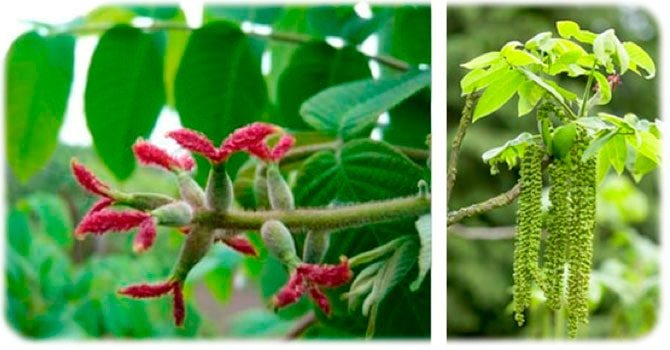
Photo - flowering of the Manchurian walnut: on the right are female flowers, on the left - male
Fruits take 5-6 months to form, are edible.
What is the difference between a walnut and a Manchu
The main difference between the Manchurian nut and its close relative, the walnut, is its frost resistance. Differences between the first and the second:
- stronger shell;
- smaller cores;
- the size of the fruits is approximately the same;
- the second is more photophilous.
In landscape design
Interestingly, the Manchurian walnut is even more decorative than the walnut. It is used for landscaping both suburban areas and cities, streets, courtyards. Parks and squares with Manchurian walnut plantings will become a very comfortable place for walking, as this culture repels mosquitoes thanks to phytoncides.
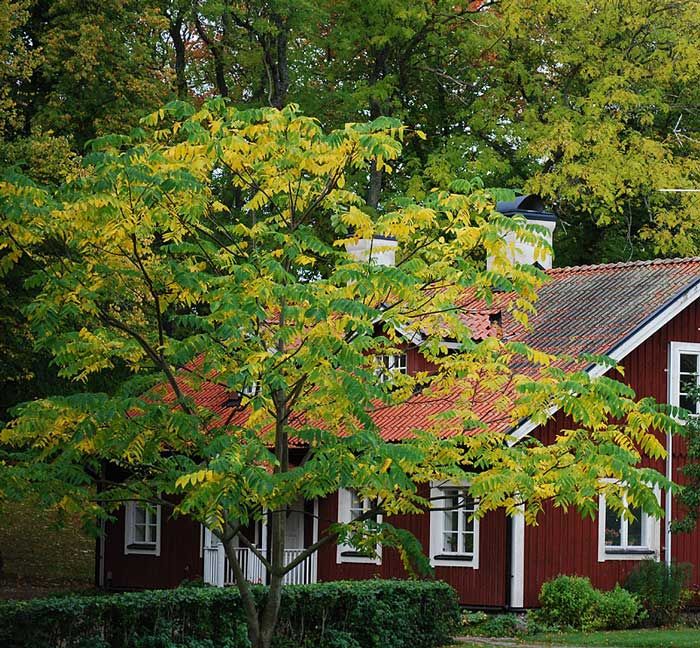

Manchurian walnut is very beautiful in autumn:
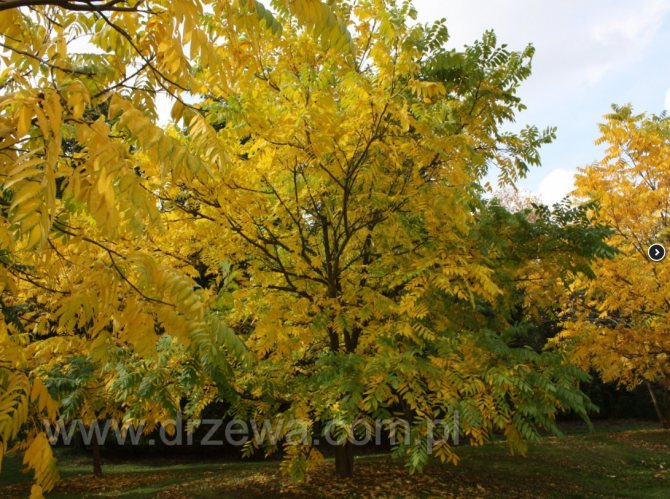

The greatest compatibility of this culture with conifers.
Manchurian walnut: cultivation
To grow a beautiful and unpretentious plant in care, it is enough to purchase a seedling or a fruit and take into account the recommendations for planting. It is worth knowing that a tree or shrub can grow on all types of soils, except for acidic ones.


Walnut seedlings are difficult to tolerate transplants
Manchurian walnut planting and care
Those who want to decorate the site and enjoy the taste of the Manchurian nut in the autumn should land according to the rules described below. It is worth considering when choosing a place that the plant belongs to light-loving, does not like acidic soil, requires constant soil moisture (especially in the early years). Location in the shade of other trees, next to buildings is unacceptable.There must be a distance of at least 10 meters between two Manchu nuts. There are no special rules for care, except for watering and fertilizing the soil.
Planting a seedling
You can plant seedlings in the spring or autumn season, months:
- September;
- April.
The pit should be prepared in advance, at least thirty days in advance. The depth of the pit is from eighty to one hundred meters. Scheme:
- Digging a hole. We spread the upper soil separately from the lower one.
- We drain the bottom with bricks, rubble, etc.
- We mix the top and bottom soil, spread the mixture over the drain.
- Clay or depleted soils must be fertilized. To do this, add humus, turf, sand 4/2/2/1 to the top of the soil in parts. Add potassium superphosphate in an amount of 20 grams (up to 40) and potassium fertilizer to the mixture. We put the resulting mixture over the drainage.
- After a month, we dig a hole for the seedling.
- Cut the central part of the root.
- We pour out the excavated soil, but not all.
- We put the seedling in the soil, check the level of the root collar with a wire or wooden stick. This part should be flush with the soil. You can also attach the seedling to a peg.
- Fill with a bucket of water.
- As the moisture is absorbed, lay out the rest of the soil.
- We make a hole around the seedling.
- Pour water - you need ½ bucket - a bucket.
- We spread peat, sawdust or mature compost on top. Mulching will retain moisture.
It is very important to pay attention to the conformity of the root collar to the soil level. The parameter will avoid subsidence. Planting in a fresh hole that has not stood for a specified period of time can lead to improper formation of the root part. Root pruning helps the tree grow faster.
How to grow a Manchu nut from a seed
When planting seeds, it should be borne in mind that the germination capacity of fruits not prepared in advance is rather low. To do this, the nuts must be kept in the refrigerator during the winter or planted in the fall. Step by step scheme:
- At the chosen place, we form a bed, dig it up, add wood ash in an amount of 2 to 3 glasses for each square meter.
- We make indentations up to 8 centimeters.
- When planting several nuts, the distance between the holes should be at least 10 cm.
- Place the nuts in kerosene for 30 seconds with the sharp side down.
- We fill the holes with soil.
- We spread peat, sawdust or compost.
Kerosene treatment will avoid damage to the planted seeds by rodents and other pests.
Care
During the first year, seedlings from the seeds can not be touched, and in the second year, they can be planted in permanent places. Watering frequency:
- the first year - at least two and no more than three times during the month;
- second or third - twice;
- further - one.
After watering, the soil must be loosened, weeds must be removed. It is necessary to fertilize the soil in June; it is better to use potassium superphosphate for these purposes. In the spring, it is necessary to whitewash so that the trunk does not get burned in hot weather. Before winter, young trees should be covered with non-woven materials.
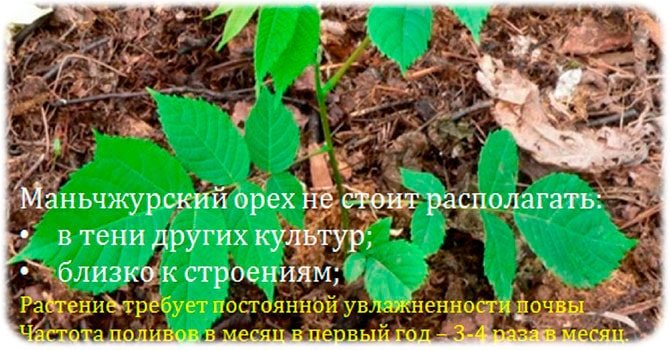

Watering is carried out 2-3 times a month without flooding the soil
Growing a tree
To understand how to plant Manchurian nut seedlings at home, you should follow the recommendations of experienced gardeners. The walnut tree is a light-loving plant and should be planted in a well-lit area. For planting, you need to purchase seedlings and tools. The procedure is recommended to be carried out in September. How to plant a Manchu fruit - instructions:
- Dig a hole about 90 cm deep.
- Before planting a tree, drainage, rubble or broken brick must be laid at the bottom of the pit.
- Plant the seedling in the hole and tie it to the peg.
- Cover the hole with earth, pour water over it.
- You need to complete the planting with mulching. For this, the soil near the seedling is treated with peat.This helps the seedlings grow without pests on the branches.
Growing must take place under acceptable conditions. With the onset of cold weather, the seedlings need to be insulated with a dense film. In the spring, the soil needs to be fertilized and saturated with useful minerals, this will help to grow a healthy tree.
Manchurian nut: calorie content, composition
Energy value for Manchurian nuts is 643 kilocalories for every hundred grams of product. Nutritional value, grams:
- proteins - 28.6;
- fat - 61.0;
- carbohydrates - 7.7.
The vitamin and mineral composition is distinguished by the presence of:
- riboflavin;
- thiamine;
- niacin;
- ascorbic acid;
- iron (in the form of salts) and other minerals.


The chemical composition contains:
- in the root part - essential oils;
- the bark is distinguished by the presence of steroids, tannins, quinones;
- leaves - essential oils / mineral salts / alkaloid compounds / aldehydes / beta-carotene / nicotinic acid / vitamin C / carboxylic acid / flavonoids / coumarins / inositol / quinones / biotin;
- in the pericarp - tannins / vitamin C / malic acid / citric acid / carotene / coumarins / quinones / phenylcarboxylic acids;
- in the shell - tannins / coumarins / phenylcarboxylic acids.
Walnut (green and ripe) is distinguished by the presence of:
- quinones;
- carotene;
- iron salts;
- magnesium;
- iodine;
- calcium;
- thiamine;
- riboflavin;
- niacin;
- ascorbic acid;
- fatty acids.
Fatty acids in ripe fruits are:
- oleic (monounsaturated);
- stearic (saturated);
- linoleic (polyunsaturated);
- lauric (monounsaturated);
- palmitoleic (monounsaturated);
- palmitic (saturated);
- arachidic (monounsaturated);
- myristic (saturated).
Thanks to linoleic acid, the body synthesizes arachidic acid, which:
- prevents excessive loss of hair shafts;
- contributes to the maintenance of vision;
- helps the body to resist dermatoses and bacterial infections.
Monounsaturated fatty acids are part of the human nervous system, polyunsaturated fatty acids keep youth, slow down the aging process. Unripe nuts contain sugars and hydrogluons (they have a wound-healing effect).
Manchurian walnut: medicinal properties
In the treatment and prevention of various diseases, tinctures and decoctions of bark, shells, leaves are used due to the presence of tannins and other substances that provide anti-inflammatory, antimicrobial effects. The fruits are effective in their pure form as a preventive / therapeutic agent:
- diseases of the cardiovascular system;
- impaired memory and other abnormalities associated with the work of the brain;
- anemia;
- diseases of the epidermis.
The broth can be used to treat inflammation, wounds in the mouth, constipation, gastritis, diarrhea, there is evidence of anti-cancer action.
The shell has a high iodine content, but it requires a long infusion to isolate valuable substances from the woody parts. Long-term treatment is effective in combating thyroid dysfunction.
IMPORTANT. The article is for informational purposes, therefore, the listed means for the purpose of treatment should be used only after consulting a doctor.
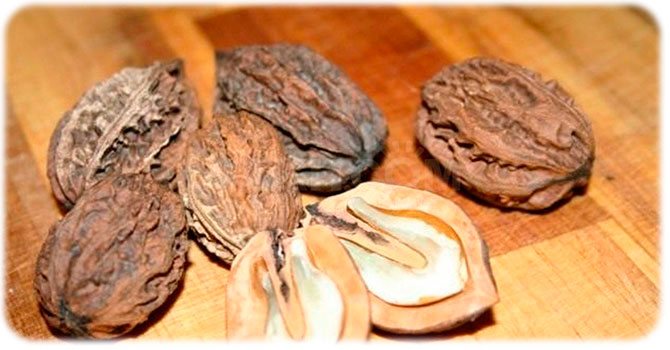

Bark decoction baths will ease the course of rheumatism
Manchurian nut: benefits
Manchurian walnut benefits and harms - properties that must be taken into account, because the use of excessively large quantities can lead to weight gain - the product consists of 60% of easily digestible vegetable fats.
The positive effects of application are expressed by the following types of influences:
- antispasmodic;
- pain reliever;
- antihelminthic;
- astringent;
- antimicrobial;
- improved work of the cardiovascular system;
- strengthening the vascular walls;
- improved elasticity of capillaries;
- improved memory and brain function;
- improved metabolism;
- normalization of glucose levels in the circulatory system;
- improved structure of hair, nails, healthy appearance of the epidermis;
- normalization of the nervous system;
- an increase in the amount of hemoglobin in the circulatory system;
- relieving fatigue.
The beneficial properties of the Manchu nut have limitations: it is worth refraining from nursing mothers, pregnant women and children under three years old. Lack of enzymes for digestion and the possibility of entering the respiratory tract are 2 reasons to postpone a baby's acquaintance with the product.
During the period of gestation, it is worth introducing previously unknown nuts into the diet only after consulting a doctor. And during breastfeeding, you can take it 4-6 months after giving birth and only if the woman has consumed Manchurian nuts during pregnancy. Otherwise, treats should be abandoned before the baby is weaned from the breast, because the product can cause severe allergy symptoms in the baby.
Benefits for women
Manchurian walnut: medicinal properties and contraindications for women, as described above, are two interrelated parameters that should be taken into account. Strengthening the hair shafts, nail plates due to the B vitamins included in the composition, the ability to influence the amount of hemoglobin in the blood due to iron in the mineral composition takes place only with regular use and in acceptable quantities.
For problem menstruation and diseases associated with impaired functioning of the thyroid gland, it is useful to use tincture. Nuts also serve as one of the measures in the fight against cellulite - it is recommended to eat 5-7 nuts after exercise.
Benefits for men
Manchurian walnut: medicinal properties and contraindications for men are characteristics that are important to consider before using. The fact is that most men over 50 years old are susceptible to myocardial infarction, strokes. Therefore, the daily use of even one nut a day serves as the prevention of diseases of the cardiovascular system.
For people whose work is connected with physical activity, nuts help get rid of fatigue. You should not ignore the property of improving potency: the vegetable protein-fat mixture is rich in vitamins and minerals that can improve men's health.
Care
It is not difficult to grow a nut, since the plant does not need increased care.
After planting, care consists of regular irrigation, feeding, mulching, protection from frost and from parasites.
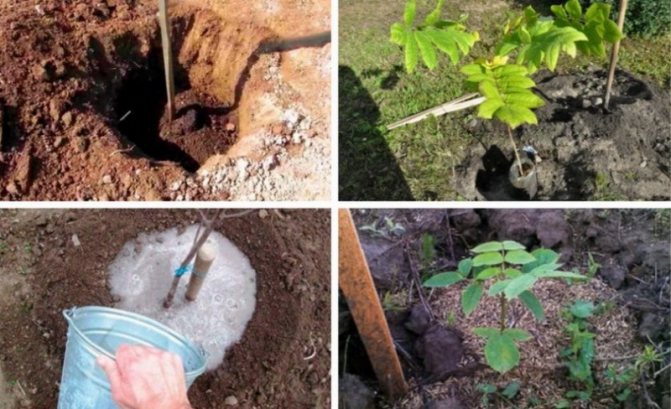

In addition, the plant should be protected from rodents. For this, a fine-mesh metal mesh is installed with a height of about a meter at a distance of 10-15 cm from the tree trunk. To prevent sunburn, the trunk is whitewashed or tall trees are planted nearby: linden, birch, beech, spruce.
Watering
Walnut trees have a high need for moisture, the plant is irrigated regularly and without stagnation of liquid. Under normal rainfall, an adult plant is irrigated 5 times per season, and young plants are irrigated twice as much. In a drought, irrigate every week for 15-20 liters. By autumn, watering is reduced, allowing the nut to prepare for winter.
Fertilizer selection and feeding
Once during the growing season (preferably in June), the nut is fertilized with phosphorus-potassium compounds. It can be fed in spring with nitrogenous fertilizers, and in winter with wood ash, which contains a set of macro- and microelements necessary for the normal development of the crop and obtaining a large harvest.
Mulching
Mulching allows you to retain moisture in the soil, insulate the roots from frost, protect from weeds and sunlight. It is advisable to mulch the Manchurian nut immediately after planting. Sawdust, peat, moss, hay are used as mulch.
To enhance the mulching effect, it is advisable to perform it immediately after feeding. When using organic matter, the mulch layer depends on the material: moss - 10 cm; sawdust - 7 cm; foliage or hay - 10-15 cm.
Preparing for winter
In autumn, you need to protect the trunk of a Manchurian nut from the approaching frost by wrapping it in felt, matting, burlap, agrofibre. For insulation, you can build a frame by filling it with sawdust from above or wrapping it with non-woven material.
Garden paint based on acrylic or latex will help increase frost resistance and protect against burns.
Pests and diseases
The Manchu walnut variety has good immunity, but diseases can affect the condition of the leaves, bark, and branches. Each disease has causes and progresses with its own characteristics:
- Black spot is a fungal disease that occurs in high humidity. It manifests itself in the fact that small dark spots form on the leaves of the plant. If untreated, a part of the crown of the Manchu nut dies off and the tree becomes weakened. For prevention and treatment, copper solutions are used.
- A tinder fungus that destroys wood, which causes the nut to dry out. Mushrooms must be cut and burned, and a solution of copper sulfate should be applied to the lesions.
- Nutcracker is a parasitic insect that infects the bark, leaves and flowers of the tree. You can get rid of the pest by cutting off the affected branches. When large areas are affected, they are sprayed with insecticides: decis, kinmix, carphobs.
- Bacterial burn is an infectious disease caused by a bacterium of the genus Erwinium. It is manifested by darkening and wilting of inflorescences, then leaves, young branches and bark are affected. They are treated with Bordeaux liquid and antibiotics.
- Gall-forming mite - affects leaf blades, deforms young shoots. To get rid of, they are sprayed with organophosphate compounds, neonicotinoids, pyrethroids. Severely affected branches are removed and burned.
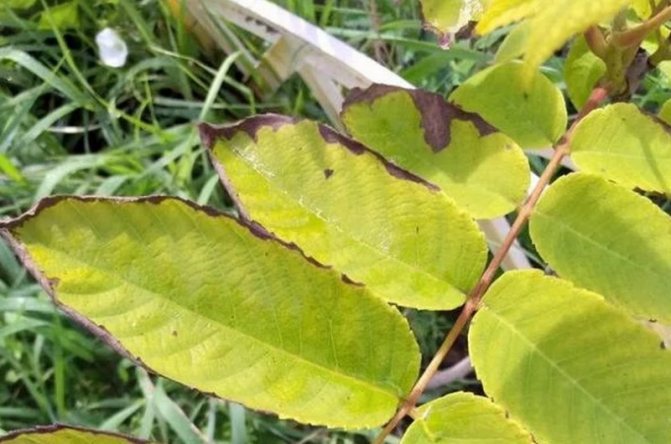

When grown correctly, the Manchu nut develops rapidly and gives its first harvest a few years after planting. In addition to regular irrigation and the prevention of bacterial and fungal diseases, you should weed and loosen the soil around the trunk.
Manchurian walnut in folk medicine
The following effects have found application in folk medicine:
- hemostatic;
- tonic;
- pain reliever;
- anti-inflammatory;
- diuretic;
- vasodilator;
- anti-cancer.
According to Chinese healers, remedies based on this plant are able to eliminate cancer cells and prevent the formation of new ones.
Traditional medicine involves the use of the following forms:
- infusion;
- hood;
- broth;
- fresh leaves.
The juice of the plant has no pronounced therapeutic effect, has a general tonic effect and can be used as an invigorating drink.
The last tool on the list acts as a tool for:
- healing wounds;
- elimination of boils;
- fight calluses.
Leaf properties:
- antiseptic;
- antimicrobial.
IMPORTANT. Fresh leaves can rightfully be called antibiotics given by nature, and a decoction is an effective way to eliminate seborrhea.
Effects of consuming products based on Manchu nuts:
- elimination of inflammation and bleeding in the oral cavity;
- treatment of periodontal disease, tonsillitis, gingivitis;
- therapy of chronic constipation, gastritis, diarrhea.
Indications for use
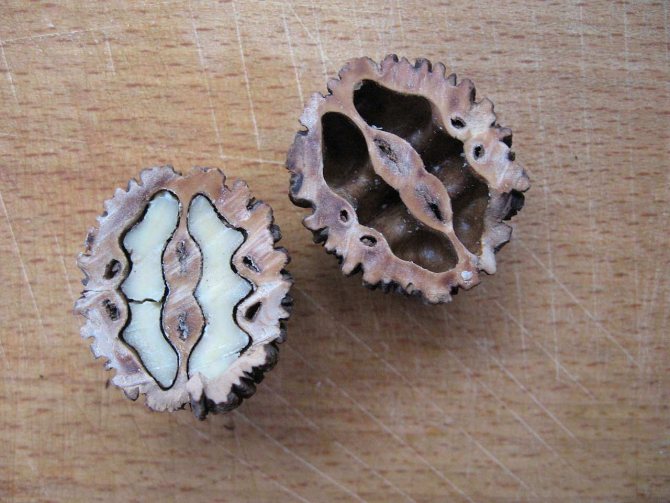

In addition to cooking, the Manchu nut is widely used in home cosmetology and folk medicine. Manchurian hazelnut - who can eat and under what pathologies:
- Anemia.
- Hypertension.
- Varicose veins.
- Internal bleeding.
- Hepatic and renal failure.
- Cardiovascular diseases.
- Helminthiasis.
- Pathology of the gastrointestinal tract. In addition to acute ulcers and gastritis.
- Viral infections, ARVI.
- Malignant neoplasms in the body.
Hazel fruits are also used for vitamin deficiency, hormonal imbalance.
Manchurian nut: harm, contraindications
Before buying, you should carefully study the product. Not fresh nuts contain mold fungi, aflatoxins, which are deadly to humans. The presence of mold, unpleasant odors, moisture on the surface can indicate the multiplication of dangerous mycotoxins. Eating too much can cause weight gain or other side effects such as:
- dizziness;
- an allergic reaction;
- dysbiosis;
- suppressed intestinal microflora.
The pronounced antimicrobial effect can negatively affect the gastrointestinal tract, killing the body's natural defenses. Contraindications include the presence of:
- obesity;
- cirrhosis of the liver;
- acute hepatitis;
- stomach ulcers;
- gastritis;
- increased blood clotting;
- the period of breastfeeding and bearing the fetus;
- children less than three years old.
In the presence of diseases or features not listed in the list, the use should be discussed with a specialist.
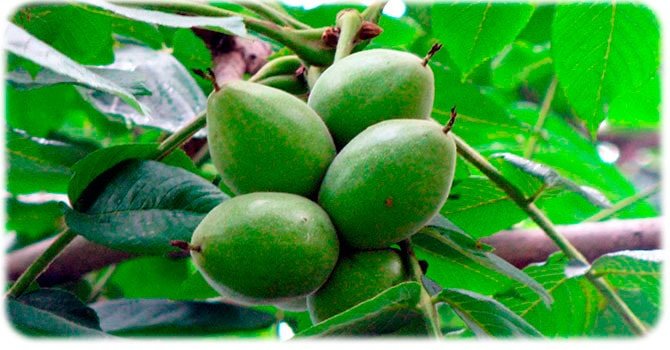

Manchurian nut oil: benefits and harms
The extract from the kernels contains fatty acids that contribute to a healthy appearance of the epidermis. The product is suitable for indoor and outdoor use. It should be taken orally before meals (preferably 20 minutes) no more than a teaspoon twice a day. Result:
- improved metabolism;
- a reduced number of units of glucose in the circulatory system;
- cleansing the body of bacterial and microbial cells.
The tool has a therapeutic effect, therefore it is used externally for the treatment of:
- gum disease (periodontitis, periodontal disease);
- depriving;
- purulent rash;
- lupus;
- deep wounds, boils;
- corns;
- fungal infections of the feet and nail plates;
- throat diseases (tonsillitis).
Manchurian nut: benefits, leaves
According to the information presented above, the leaves of the plant are unique: they can be used fresh and as decoctions. Range of application:
- treatment of skin wounds, inflammations;
- elimination of dandruff.
The pronounced antimicrobial effect contributes to the rapid healing of wounds.
Manchu nut juice
The drink obtained in spring with the help of notches on the trees has an invigorating, tonic effect and does not have a pronounced therapeutic effect. The sap of the tree can be used as a remedy for fatigue.
How to properly propagate a walnut tree?
It is not difficult to grow a young nut seedling - the culture is perfectly propagated by seeds, which remain viable for 3 years.
Preparation of nuts for sowing is carried out in 2 ways:
- For sowing in the spring months, nuts are used, pre-stratified, aged until spring in a cold place. 10 days before planting, the nuts are soaked in warm water, which needs to be changed frequently.
- There is a method of accelerated stratification of nuts, in which in the first decade of March the fruits are soaked in hot water for a day, after which they are placed in wet sand until seedlings appear.
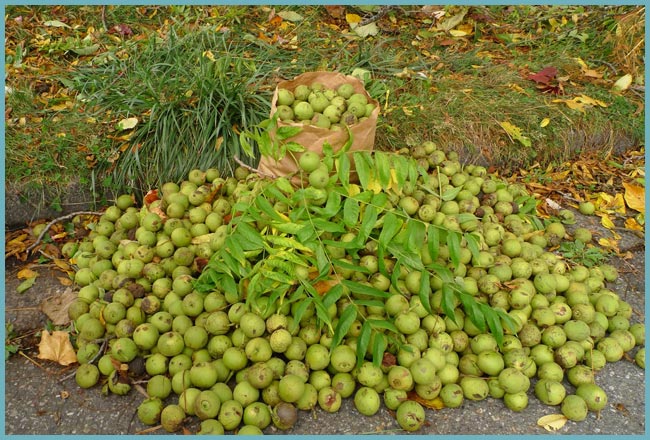

Manchurian nut fruit
Planting nuts for culture propagation is allowed both in spring and autumn, but stronger trees are formed during spring planting.
Advice! Rodents love to dig up planted nuts and feast on them. To protect the planting material, you can treat the walnut shells with kerosene.
How to choose and store a Manchurian nut
If you have not yet grown this picturesque tree or shrub on the site and the opportunity has turned up to purchase its fruits, carefully examine it, it is unacceptable:
- heterogeneity of color;
- the presence of spots and darkening on the surface;
- rancid odor;
- the presence of moisture, traces of rot, mold.
These signs can serve as a reason for refusal to purchase.
You can store it unpeeled from the shell in a cool place with a temperature not exceeding 14 degrees Celsius for no more than a year. Over time, beneficial substances degrade and harmful ones are formed, therefore, the fruits of the plant that have been stored for too long should not be consumed. Conditions for kernels:
- in a cool place protected from direct sunlight - no more than 1 month;
- refrigerator - up to 6 months;
- freezer - up to 1 year.
Store in an airtight container to exclude the possibility of air ingress.
Use in the decoration of the site
The plant is great for landscaping. It can be formed both in the form of a shrub and in the form of a tree. The crown is spreading, growing rapidly, therefore, within 1 year after planting, whole compositions can be made from young hazel. The culture is light-loving, so it is usually used as the highest part of the planting, or it is planted in front. It is not afraid of winds, so it is suitable for refining small hills and open areas that are not protected from gusts of air.
Hazel can be easily combined with both deciduous and coniferous plants. Looks best next to junipers, cedars, larch trees. Professionals plant hazel along the perimeter, forming a decorative fence from it, or create compositions in the center of the site. The Manchu walnut looks especially impressive against the background of green lawns lined with a roll lawn.
The plant can be grafted onto the Ussuri walnut. About 40% of vaccinations take root successfully.
Brief summary
- Manchurian walnut is unpretentious in care, and you can plant kernels or seedlings. Tolerance to frosts up to -48 degrees Celsius makes it possible to grow a plant in Siberia, the Leningrad region, central Russia and other regions.
- A tree or shrub grows on all but acidic types of soil.
- Shells, leaves, bark have healing properties. Decoctions are prepared to treat inflammation in the mouth or digestive disorders.
- Pregnant women should only be taken with the permission of a doctor; nursing mothers should refrain from eating nuts so as not to cause an allergic reaction in the baby.
- Do not give to children who are under three years old - the body has not yet synthesized enzymes for digesting nuts.
Dumbay nut oil
Manchu nut oil is considered an extraordinary and healing remedy. It is taken orally, used topically. When used internally, they drink 5 ml of oil twice a day before the main meal. A monthly therapeutic course will cleanse the body, strengthen the immune system, improve the condition of the skin, and normalize metabolic processes.
Oil is used locally for:
- purulent rashes, lichen, eczema, psoriasis, lupus erythematosus;
- long non-healing wounds, furunculosis;
- painful calluses on the palms and feet;
- diseases of the oral cavity;
- fungus on feet, nails, hands;
- sore throat, tonsillitis, pharyngitis and other inflammations affecting the throat.
Many people confuse nut juice with butter. The juice has practically no medicinal properties, but it perfectly tones and invigorates. It is often harvested in the spring when the juice is filled with pleasant sweetness and aroma.

